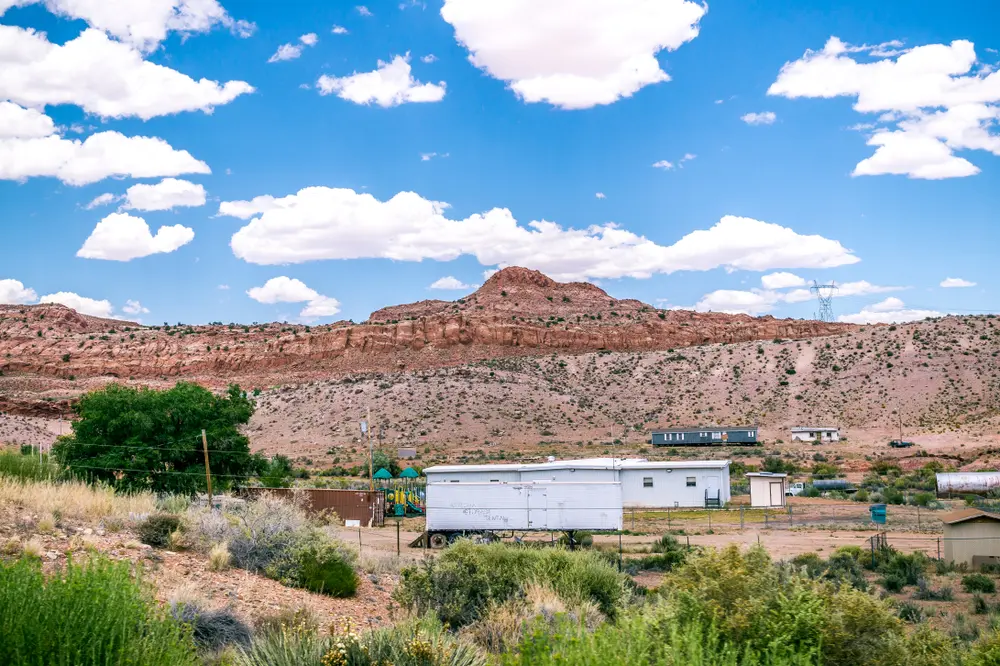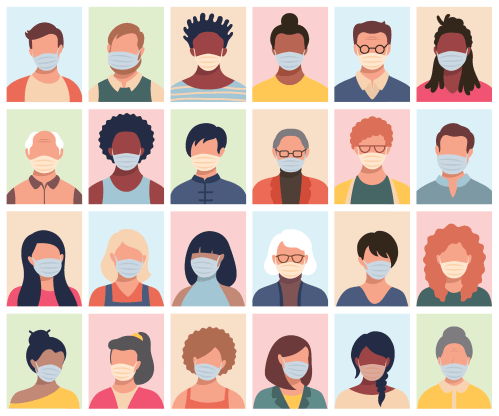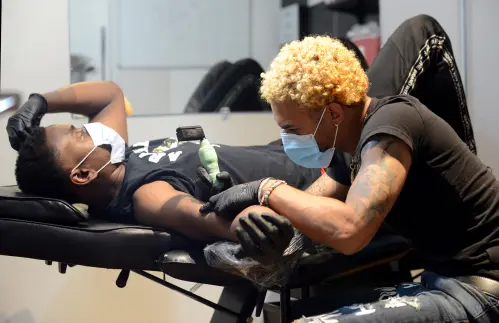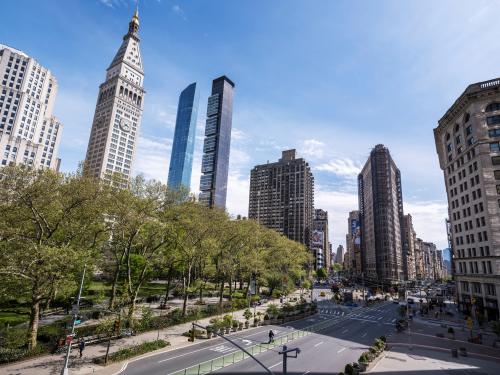American Indians and Alaska Natives (AIAN) are dying of COVID-19 at much higher rates and at younger ages than other groups. In some states, the COVID-19 death rate for AIAN people is similar to that of whites who are 20 to 30 years older. These disparities–together with both a recent and long history of racism and crimes against First Nations–make a strong case that federal, state, and local governments should make every effort to work with Tribal governments and the Indian Health Services (IHS) to ensure scarce vaccine resources are allocated to, and ultimately reach, American Indians and Alaska Natives of all ages as soon as possible.
Recent media reports point to high death rates and highlight the loss of elders and fluent Indigenous language speakers. Here we show that analyzing death rates by age and focusing on states where data are most complete reveals even more shocking disparities.
Race gaps in COVID-19 deaths: including AIAN
Researchers (including one of us) often exclude American Indians and Alaska Natives from analysis because data for that group are unavailable or difficult to interpret. In this post, we use the best available data to shine a light on the devastating impact of the pandemic on AIAN communities, which were already facing many challenges.
An estimated 2.4 million people identify as AIAN alone (not in combination with any other race or ethnicity)1, 21 percent of whom live on American Indian reservations. The poverty rate for AIAN people (23 percent) is similar to that of Black people (21 percent), but much higher than the average (12.3 percent); and American Indians residing on reservations have some of the highest rates of chronic diseases and mortality in the country. Access to health care for AIAN people on or near reservations and management of IHS has improved in recent decades, however, facilities are often still lacking some basic infrastructure to meet public health needs.
According to Centers for Disease Control (CDC) data, the age-adjusted COVID-19 mortality rate is now higher for AIAN people than for any other group (Figure 1); it is almost two and a half times the death rate for whites and Asians.2 Figure 1 also shows that the disparities for Blacks and Hispanics/Latinos relative to whites, that we identified in June, remain substantial.3 (That post also explains why it is important to adjust for age when comparing across groups.)
We use data from the CDC on COVID-19 mortality (reported to CDC by states), which are preliminary and reported with a lag. (For example, as of February 10, the CDC data include 443,000 deaths nationally while the New York Times was reporting about 473,000.) Additionally, not all states report deaths for all Office of Management and Budget race/ethnicity groups, and the CDC suppresses reporting of deaths less than 10 to protect privacy; this affects the reporting of deaths for smaller groups more often. And to construct death rates we need population estimates, which can be tricky especially for American Indians and Alaska Natives since their relatively small population sizes are more sensitive to sampling techniques, response rates, and definitions.
Despite these limitations, we think these data provide important insight into mortality disparities and, if anything, may understate AIAN death rates for two reasons: First, many states have not been reporting deaths separately for AIAN, but the population estimates used in the denominator include AIAN people in all states. In addition, AIAN people are often mis-categorized as a different race/ethnicity on death certificates due to unfamiliarity with the AIAN population.
AIAN populations dying at higher rates and younger ages
We focus the rest of our analysis on six states where AIAN people make up more than 1.5 percent of the population, where we expect data problems to be less severe.4 These states account for 40 percent of the AIAN population. We compare AIAN mortality with that of whites (which is reported in all states). Figure 2 shows how age-adjusted COVID-19 death rates for the two groups compare in each state. For example, in Montana, age-adjusted death rates are seven times higher (first panel) for AIAN people than for whites. For every 100,000 in the population, 737 AIAN people have died of COVID-19 versus 105 whites. In fact, AIAN COVID-19 mortality is high relative to that of whites in all six states, ranging from about double in Oklahoma to 10 times in New Mexico.5
People dying of COVID-19 in AIAN communities are much younger, on average, compared to white victims. At the same time, COVID-19 is killing AIAN elders at an alarming rate.
Figure 3 shows the age distribution for AIAN and white people killed by COVID-19 in the six states shown in Figure 2. More than 40 percent of AIAN COVID-19 victims were under 65 years old, compared to about 11 percent of white COVID-19 victims; and 37 percent of white COVID-19 victims were in the oldest age group—85 or older—compared to just 12 percent of AIAN victims. The majority of COVID-19 deaths in the white population were 75 or older, while for the AIAN population deaths are concentrated among those under 75.
All COVID-19 deaths are tragic, but whereas in white communities, the vast majority of COVID-19 victims are elderly, in American Indian communities, COVID-19 is more frequently depriving people of the opportunity to grow old at all.
People dying of COVID-19 in AIAN communities are much younger, on average, compared to white victims. At the same time, COVID-19 is killing AIAN elders at an alarming rate.
Figure 3 shows the age distribution for AIAN and white people killed by COVID-19 in the six states shown in Figure 2. More than 40 percent of AIAN COVID-19 victims were under 65 years old, compared to about 11 percent of white COVID-19 victims; and 37 percent of white COVID-19 victims were in the oldest age group—85 or older—compared to just 12 percent of AIAN victims. The majority of COVID-19 deaths in the white population were 75 or older, while for the AIAN population deaths are concentrated among those under 75.
All COVID-19 deaths are tragic, but whereas in white communities, the vast majority of COVID-19 victims are elderly, in American Indian communities, COVID-19 is more frequently depriving people of the opportunity to grow old at all.
People 85 and older account for a smaller share of deaths among AIAN people in part because large disparities in death rates at younger ages even absent COVID-19 mean that too many American Indians and Alaska Natives never make it to older ages in the first place. Although the numbers are relatively small, the rate of deaths at older ages is alarming. Figure 4 shows age-specific death rates for white and AIAN people in the three states with the most disproportionate AIAN mortality from Figure 2. For example, COVID-19 death rates for 35-44 year-olds in Arizona are 9 and 250 per 100,000 for white and AIAN people, respectively.
Figure 4 reveals high COVID-19 death rates and extreme inequality, for example:
- In both Arizona and New Mexico, the death rate for American Indians and Alaska Natives 85 and over is over 5,700. This means that over 5.7 percent of that group has been lost to COVID-19.
- In Montana, 3.8 percent of all American Indians 75-84 and 4.6 percent of those 85 and older have died of COVID-19.
- In Arizona and New Mexico, the death rates for AIAN people aged 45-54 are similar to those of whites aged 75-84. This means that AIAN people are dying of COVID-19 at a rate similar to whites who are 30 years older than them.
- In all three states, death rates for AIAN people are, on average, similar to those of whites who are 20 to 30 years older than them.
People dying of COVID-19 in AIAN communities are much younger, on average, compared to white victims. At the same time, COVID-19 is killing AIAN elders at an alarming rate.
Figure 3 shows the age distribution for AIAN and white people killed by COVID-19 in the six states shown in Figure 2. More than 40 percent of AIAN COVID-19 victims were under 65 years old, compared to about 11 percent of white COVID-19 victims; and 37 percent of white COVID-19 victims were in the oldest age group—85 or older—compared to just 12 percent of AIAN victims. The majority of COVID-19 deaths in the white population were 75 or older, while for the AIAN population deaths are concentrated among those under 75.
All COVID-19 deaths are tragic, but whereas in white communities, the vast majority of COVID-19 victims are elderly, in American Indian communities, COVID-19 is more frequently depriving people of the opportunity to grow old at all.
People 85 and older account for a smaller share of deaths among AIAN people in part because large disparities in death rates at younger ages even absent COVID-19 mean that too many American Indians and Alaska Natives never make it to older ages in the first place. Although the numbers are relatively small, the rate of deaths at older ages is alarming. Figure 4 shows age-specific death rates for white and AIAN people in the three states with the most disproportionate AIAN mortality from Figure 2. For example, COVID-19 death rates for 35-44 year-olds in Arizona are 9 and 250 per 100,000 for white and AIAN people, respectively.
Figure 4 reveals high COVID-19 death rates and extreme inequality, for example:
- In both Arizona and New Mexico, the death rate for American Indians and Alaska Natives 85 and over is over 5,700. This means that over 5.7 percent of that group has been lost to COVID-19.
- In Montana, 3.8 percent of all American Indians 75-84 and 4.6 percent of those 85 and older have died of COVID-19.
- In Arizona and New Mexico, the death rates for AIAN people aged 45-54 are similar to those of whites aged 75-84. This means that AIAN people are dying of COVID-19 at a rate similar to whites who are 30 years older than them.
- In all three states, death rates for AIAN people are, on average, similar to those of whites who are 20 to 30 years older than them.
People dying of COVID-19 in AIAN communities are much younger, on average, compared to white victims. At the same time, COVID-19 is killing AIAN elders at an alarming rate.
Figure 3 shows the age distribution for AIAN and white people killed by COVID-19 in the six states shown in Figure 2. More than 40 percent of AIAN COVID-19 victims were under 65 years old, compared to about 11 percent of white COVID-19 victims; and 37 percent of white COVID-19 victims were in the oldest age group—85 or older—compared to just 12 percent of AIAN victims. The majority of COVID-19 deaths in the white population were 75 or older, while for the AIAN population deaths are concentrated among those under 75.
All COVID-19 deaths are tragic, but whereas in white communities, the vast majority of COVID-19 victims are elderly, in American Indian communities, COVID-19 is more frequently depriving people of the opportunity to grow old at all.
People 85 and older account for a smaller share of deaths among AIAN people in part because large disparities in death rates at younger ages even absent COVID-19 mean that too many American Indians and Alaska Natives never make it to older ages in the first place. Although the numbers are relatively small, the rate of deaths at older ages is alarming. Figure 4 shows age-specific death rates for white and AIAN people in the three states with the most disproportionate AIAN mortality from Figure 2. For example, COVID-19 death rates for 35-44 year-olds in Arizona are 9 and 250 per 100,000 for white and AIAN people, respectively.
Figure 4 reveals high COVID-19 death rates and extreme inequality, for example:
- In both Arizona and New Mexico, the death rate for American Indians and Alaska Natives 85 and over is over 5,700. This means that over 5.7 percent of that group has been lost to COVID-19.
- In Montana, 3.8 percent of all American Indians 75-84 and 4.6 percent of those 85 and older have died of COVID-19.
- In Arizona and New Mexico, the death rates for AIAN people aged 45-54 are similar to those of whites aged 75-84. This means that AIAN people are dying of COVID-19 at a rate similar to whites who are 30 years older than them.
- In all three states, death rates for AIAN people are, on average, similar to those of whites who are 20 to 30 years older than them.
People dying of COVID-19 in AIAN communities are much younger, on average, compared to white victims. At the same time, COVID-19 is killing AIAN elders at an alarming rate.
Figure 3 shows the age distribution for AIAN and white people killed by COVID-19 in the six states shown in Figure 2. More than 40 percent of AIAN COVID-19 victims were under 65 years old, compared to about 11 percent of white COVID-19 victims; and 37 percent of white COVID-19 victims were in the oldest age group—85 or older—compared to just 12 percent of AIAN victims. The majority of COVID-19 deaths in the white population were 75 or older, while for the AIAN population deaths are concentrated among those under 75.
All COVID-19 deaths are tragic, but whereas in white communities, the vast majority of COVID-19 victims are elderly, in American Indian communities, COVID-19 is more frequently depriving people of the opportunity to grow old at all.
People 85 and older account for a smaller share of deaths among AIAN people in part because large disparities in death rates at younger ages even absent COVID-19 mean that too many American Indians and Alaska Natives never make it to older ages in the first place. Although the numbers are relatively small, the rate of deaths at older ages is alarming. Figure 4 shows age-specific death rates for white and AIAN people in the three states with the most disproportionate AIAN mortality from Figure 2. For example, COVID-19 death rates for 35-44 year-olds in Arizona are 9 and 250 per 100,000 for white and AIAN people, respectively.
Figure 4 reveals high COVID-19 death rates and extreme inequality, for example:
- In both Arizona and New Mexico, the death rate for American Indians and Alaska Natives 85 and over is over 5,700. This means that over 5.7 percent of that group has been lost to COVID-19.
- In Montana, 3.8 percent of all American Indians 75-84 and 4.6 percent of those 85 and older have died of COVID-19.
- In Arizona and New Mexico, the death rates for AIAN people aged 45-54 are similar to those of whites aged 75-84. This means that AIAN people are dying of COVID-19 at a rate similar to whites who are 30 years older than them.
- In all three states, death rates for AIAN people are, on average, similar to those of whites who are 20 to 30 years older than them.
What if whites had died at the same rates?
To highlight the magnitude of these disparities, we did another set of calculations. What if whites had died at the same rate as same-aged American Indians and Alaska Natives in these states? Table 1 shows the results.
Table 1. Actual and Projected COVID-19 Deaths among Whites, Selected States
| Total | Under 65 | 65 and Over | ||||
| Actual COVID-19 Deaths | Projected COVID-19 Deaths | Actual COVID-19 Deaths | Projected COVID-19 Deaths | Actual COVID-19 Deaths | Projected COVID-19 Deaths | |
| Arizona | 6,318 | 37,325 | 699 | 10,548 | 5,619 | 26,777 |
| Montana | 1,060 | 7,341 | 94 | 1,865 | 966 | 5,475 |
| New Mexico | 869 | 8,148 | 79 | 1,981 | 790 | 6,167 |
Note: Projected COVID-19 deaths is the number of deaths that would have occurred among whites if they had experienced the actual age-specific death rates as in the AIAN population.
Sources: Authors calculations using COVID-19 deaths data are from the Centers on Disease Control and Prevention “Deaths involving coronavirus disease 2019 (COVID-19) by race and Hispanic origin group and age, by state”; the denominator is Census “Single-Race Population Estimates for 2019 by State and Single-Year Age” available at CDC Wonder.
- In Arizona, 6,318 whites have died of COVID-19. If whites in Arizona had died at the same rate as their AIAN counterparts, over 37,000 white people would have been lost to COVID-19. Among those under 65, COVID-19 has killed about 700 whites in Arizona; that number would be more than 10,000 if whites had experienced AIAN death rates.
- In Montana, 1,060 white people have died of COVID-19, including 94 people under age 65. If white Montanans died at the same rate as their AIAN counterparts, COVID-19 would have killed over 7,000 white Montanans, including 1,865 under age 65.
- In New Mexico, over 8,000 white people would have died if they faced the same death rates as AIAN people, instead of the 869 who actually have died of COVID-19; almost 2,000 white people under 65 would have died, compared to 79 actual deaths among whites under 65.
Get better data, prioritize AIAN communities for vaccination
These disparities point to an urgent need to make sure vaccines quickly reach AIAN communities. Unfortunately, many states are not reporting the racial composition of those receiving vaccines, and the Census PULSE survey–the main federal survey collecting data about vaccination–does not report AIAN vaccination rates separately. This highlights the need to collect and make accessible data disaggregated by race/ethnicity to make disparities visible, support evidence-based policymaking, and promote health equity. President Biden has taken an important first step in a recent Executive Order, acknowledging that “many Federal datasets are not disaggregated by race, ethnicity, gender, disability, income, veteran status, or other key demographic variables. This lack of data has cascading effects and impedes efforts to measure and advance equity.”
Anecdotal reports suggest the vaccination effort is going relatively well in some AIAN communities. A Delphi-Carnegie Mellon University (CMU) survey of Facebook users suggests AIAN people have the highest vaccination rate of any racial/ethnic group, but that is still less than 13 percent of adults, and the sample of Facebook users may not be representative. A national survey found that 75 percent of American Indians were willing to get the vaccine, yet almost 40 percent reported having difficulty getting to a clinic for an appointment. Governments at all levels should work to bridge this gap and ensure speedy vaccine access for American Indians and Alaska Natives.
-
Footnotes
- Those who identify as non-Hispanic AIAN alone account for about one-third of all people who identify as AIAN because many people who self-identify as AIAN are mixed-race or Hispanic/Latino. About 6.9 million people in the U.S. (about 2 percent of the population) identify as AIAN alone or in combination with one or more other race. Almost 70 percent of this population resides in urban, non-reservation locations. In this piece, we focus on those who identify as non-Hispanic AIAN alone since that most closely matches the definition used on death certificates.
- Hispanics/Latinos can be of any race; Asian, white, Black, and AIAN are non-Hispanic/Latino, we omit the non-Hispanic modifier for ease of exposition. We exclude mixed-race, unknown race, and Native Hawaiian and Pacific Islanders (NHPI) from this analysis due to data limitations, though some data suggest NHPI people also face elevated COVID mortality risk.
- Data reported by APM Research Lab suggest the NHPI and Hispanic/Latino populations all have somewhat higher COVID-19 death rates than AIAN people. This likely reflects differences in data sources, dates covered, and age-adjustment method, but regardless of data and method, age-adjusted death rates for all three groups are at least double that of whites and Asians.
- The included states are Arizona, Montana, New Mexico, North Dakota, Oklahoma, and South Dakota. More than 1.5 percent of the population is AIAN in Alaska and Wyoming, but the COVID-19 death counts are suppressed for a number of age groups in these states, complicating the comparisons across race groups. We exclude those states from this analysis, but the available data in those states are consistent with age-adjusted death rates for AIAN people that are at least four times those of whites.
- Many people who self-identify as AIAN on government surveys also identify with one or more other races. We define AIAN as those who identified as non-Hispanic AIAN only throughout. The estimated AIAN COVID-19 death rates are slightly lower if we instead use non-Hispanic AIAN alone or in combination with one or more other races, but the patterns relative to whites are similar to what we report here.







